Newcomers and seasoned travellers alike to China’s capital city face a number of options on how to spend their time and what to see during their stays. Choosing between must-have and nice-to-have experiences can be a bit much to bite off alone, so this post is here to come to the rescue, lining up some spectacular landmarks for you to enjoy around town. Although I limited the choice of just eight things to see in Beijing, there could well be over a thousand things to track down in this mega metropolis - we’re only just focused on the most (rightly) famous in this article.
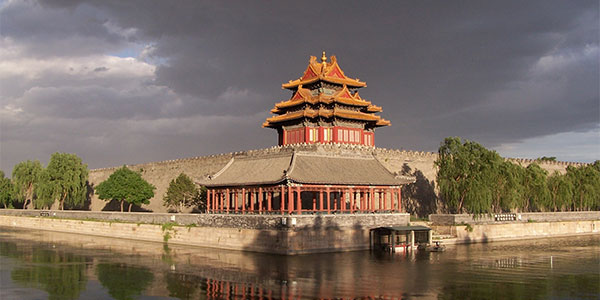
These recommendations are in no particular order, so read the whole thing before you go rushing out the door, lest you miss killing two birds with one stone (like the Great Wall and the Ming Tombs!); and, each of these selections is offered with a first time visitor in mind (as opposed to a subject specialist - if that’s you, you might want to see "5 Things to Do in Beijing (That You Probably Don't Know)" for a sampling of some of the city’s less well-known - but still spectacular - attractions).
No two travellers are ever going to have identical needs when it
comes
to seeing what Beijing has on offer... but this list gives you a
jumping off point for your trip (or even a full trip in its own right,
if you don’t have much time) that will make sure you see some of the
most impressive things the city has to show - the ones that people
around the world think of when they think "Beijing."
Hutongs (胡同)
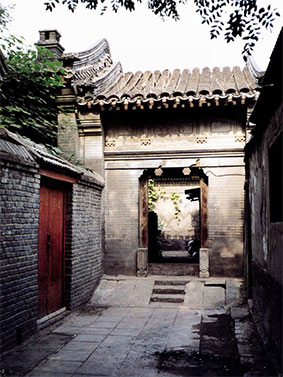 Let’s take
a step back in time; no Beijing tour is complete without a
ride around this ancient city’s alleyways housing
hutongs where families originally lived (and still sometimes do).
Let’s take
a step back in time; no Beijing tour is complete without a
ride around this ancient city’s alleyways housing
hutongs where families originally lived (and still sometimes do).
Getting to where the hutongs are is part of the experience, beginning with your ride aboard a pedicab (assuming you didn’t just hop in a taxi!); sit back and relax and leave the pedal work to your friendly rickshaw navigator.
I recommend two sites when you are ready to get set with hutong exploring: you can head for the Shichahai area to the north of Beihai Park, and then there’s the Dazhalan district to the south of Tiananmen Square. Both of these house a large collection of well-preserved hutongs, and are common destinations for visitors to Beijing wanting to see how residents lived throughout much of the city’s history.
Historians believe that hutongs probably first appeared around the
Forbidden City - the Chinese emperor’s abode - during the Qing, Ying
and Yuan dynasties. We are talking
about a period in time from around 1206 right through to the early
nineteenth century, when emperors ruled supreme. They ordained that
hutongs be laid out to allow more affluent residents to live closer to
the Forbidden City. A typical design is a layout comprising four
houses, forming a rectangular structure clustered around a center
courtyard.
Visiting Beijing’s hutongs conjures up images of a bygone era of Chinese history in the imaginations of the many tourists walking about the hutong areas in search of that old world Oriental charm. Many tours commence with a visit to the hutong district, before moving on to the other amazing attractions of this storied city.
Tiananmen Square (天安门广场)
This enormous square is the third biggest city square anywhere on the planet, although it isn’t actually square! Technically speaking, it is rectangular in shape, and let the record reflect that we are talking about 109 acres covering a substantial 440,000 m². This most famous of all squares continues to hold tremendous cultural significance to the citizens of Beijing.
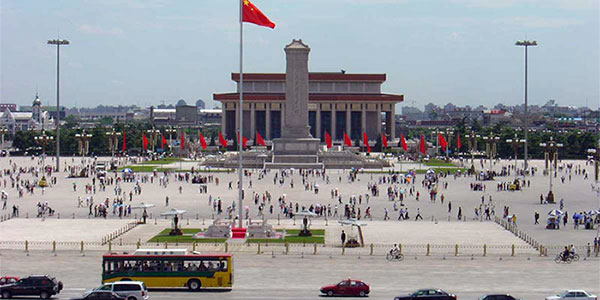
For those of you liking a little history thrown in, Tiananmen Square
dates back to 1415 under the Ming Dynasty,
nine years after construction of the Forbidden City (directly across
from Tiananmen) began in 1406. It once housed a massive ceremonial gate
named, at various times, the "Great Ming Gate," the "Great Qing Gate,"
and the "Gate of China," though this was demolished in 1950 to allow
for further expansion of the square.
A couple of other statistics to attract your interest: a mausoleum
was
erected in 1977 to the honor of Chairman Mao, who passed away in 1976 -
you can still see the embalmed remains of Mao in the mausoleum, though
no photographs are allowed, and
it is said that the square is capable of accommodating more than
600,000 citizens. Awesome indeed! Finding
Tiananmen Square is as easy as asking any local for the
directions – hand gestures are quite universal, and often all you need
(just say "Tiananmen" and point), and if you take the subway, either
the "Tiananmen East" or "Tiananmen West" subway stations will do the
job.
Forbidden City (紫禁城)
Immediately across the street from Tiananmen Square, and a natural
next stop on your trip, is the Forbidden City.
Just the name is enough to intrigue and entice; if it’s forbidden then it has to be experienced, right? So named because any commoner entering the grounds without express permission from the emperor would be summarily put to death (it really was forbidden), put on your favorite walking shoes and get ready to tour about the emperor's old digs; a good tour guide will add hugely to the experience.
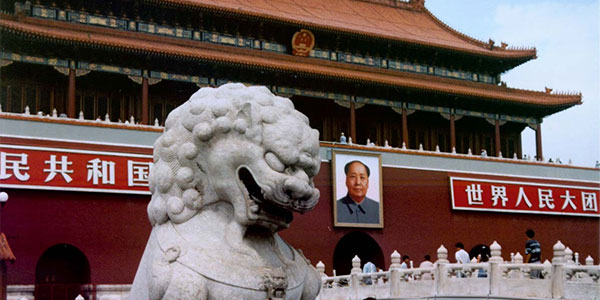
The Forbidden City is a 250-acre (720,000 m²) palace complex constructed in the early 15th century under China’s Mongol Yuan Dynasty. You’ll find a total of 980(!) buildings making up this alluring (and sprawling) place. As with most ancient relics, the City has suffered fires, pillaging, and plundering over the years, but the present architecture comes to us from the Qing Dynasty rebuild in the 18th century.
When it comes to things to see in Beijing, consider booking a tour
guide ahead of time; you’ll need RMB
60 per adult for entrance, which you can pay at the entrance when you
get there, but
don’t forget the guide’s fee too if you plan to book with a guide to
explain all the sights and structures.
While there are guides offering their services out in front of the City
to tourists just arriving, their prices will tend to be higher than
what you'd pay for a guide you'll book in advance, unless you don’t
mind a little haggling.
Plaques in English throughout the Forbidden City explain many of the
things you'll see, but a guide can help make for a richer experience.
Getting there is relatively easy using public transport. Just speak to your friendly hotel concierge for directions. Depending on which area of Beijing you’re based in, several different buses will whisk you to the nearby Tian Am Men stop or Zhongshan Phongshan Park, from where access to the Forbidden City is straightforward. Allow a good couple of hours to take in what’s on offer - even if you just walk straight through without taking any of the (many) side paths and diversions, there’s a lot to see.
Great Wall of China (万里长城)
Running from Hebei Province in the east up to and along the southern
border of Inner Mongolia, a Chinese autonomous region, the Great Wall
stretches 13,171 miles (21,196 km) - over half the circumference of the
Earth. It's big.
Erected as a series of fortifications to protect the population from raids and invasions, the Wall is made from an assortment of stone, rock, brick, and pretty well any other materials handy during its construction. Its orientation is generally east-to-west, although its builders took into account local topography for reasons of practicality. Several parts of the Wall have been dated as early as the 7th century B.C. Over time, the smaller sections were joined up to form the Great Wall we know today.
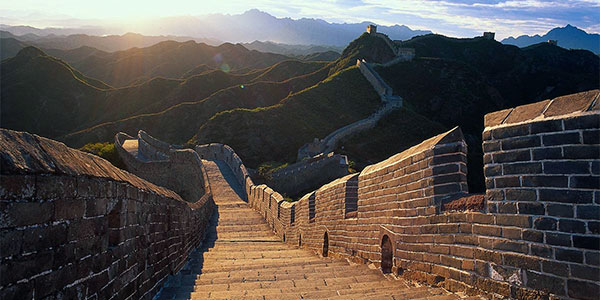
There are a number of sections reachable from Beijing. The most popular of these sections among visitors include Juyongguan, Badaling, Jiankou, Gubeikou, Simatai, Huanghuacheng and Jinshanling, with Badaling being the most heavily trafficked and commonly visited of these. There is also recently restored Mutianyu, which is farther than Badaling, but in wonderful condition and currently only lightly visited by tourists - if you want a section in great condition but without the crowds of Badaling, Mutianyu is the section you want.
Your hotel concierge will be able to help you choose if you’re
having any trouble doing so, and arrange transport for you or, if
you’re feeling a bit more adventurous (or want to save yourself a bit
of money), point you to the right bus to take you there. Make sure to
where some shoes with traction - some parts of the Wall are steep (and
a little slippery!).
National Grand Theatre (国家大剧院)
So far, all the exciting things to see in Beijing we’ve covered have
involved daytime pursuits. However, if
you’re a theater buff (or even if you aren’t), an evening at the opera
may well be in order. Beijing's National Grand Theatre (also National
Centre for the Performing Arts) delivers East Asian opera at it’s
finest.
Opera in Beijing means drama at its brilliant best, and it offers a full spectrum of action-filled entertainment. From singing and dancing, to colorful play acting, there’s even dramatic engagement through colorful characters re-enacting ancient feuds in acrobatic splendor. The musical accompaniment will be a new and exciting experience for you. There’s something to suit every taste, and it is all thanks to passionate actors reveling in every human emotion.
(performance at National Grand Theatre)
(tour / documentary of National Grand Theatre)
In Beijing opera, there are four main character roles, including Sheng (male performers), Jing (painted-face male performers), Dan (young female performers), and Chou (clowns of either gender). Their jobs are to thrill the audience to the hilt, and they’ll use both their verbal skills and talents with movements and gestures to get the message across. It’s all there to see, and it plays out amid feelings of anger, sadness, trepidation, and even fear. One moment it’s shock, even sadness and then a sudden switch to laughter and elation - but that’s what good theatre is all about the world over!
Booking is essential, and easy enough to do at your hotel. The receptionists will be only too pleased to point you in the right direction. Remember to ask them about dress code as well - best to show up in the right clothes!
Summer Palace (颐和园)
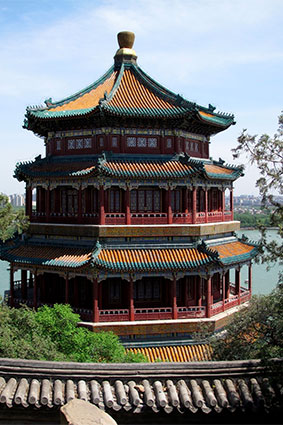 Joining
UNESCO’s World Cultural
Heritage List in 1998, the Summer Palace once was, as the name
suggests, the
imperial retreat of the emperor in the fierce Beijing summer heat.
Surrounded by the pristine waters of Lake Kunming, the Chinese name for
the Summer Palace written in Pinyin is Yíhé Yuán, literally translating
to
“Gardens of Nurtured Harmony”.
Joining
UNESCO’s World Cultural
Heritage List in 1998, the Summer Palace once was, as the name
suggests, the
imperial retreat of the emperor in the fierce Beijing summer heat.
Surrounded by the pristine waters of Lake Kunming, the Chinese name for
the Summer Palace written in Pinyin is Yíhé Yuán, literally translating
to
“Gardens of Nurtured Harmony”.
What can you expect to find when you get here? For starters, you’ll
experience an absolute masterpiece in the Palace’s landscaped gardens,
all in the Chinese vernacular of course. The
setting is idyllic, with undulating hills and open lakes melding
harmoniously with manmade structures: temples, pavilions, halls - and
let’s not
forget the Palace itself, of course! Lovely bridges combine with
alluring pathways to take the visitor gently through exquisite
surroundings. The grounds even play host to the Marble Boat, a
pavilion in the shape of a full-size Chinese boat, made of wood but
painted to resemble marble, standing on a solid stone base.
The Summer Palace is perhaps the single most aesthetically pleasing environment in Beijing.
Located in the Haidian District to the northwest of central
Beijing, the Palace covers an area of 10 square miles. Getting
here is easy enough - Xiyuan Station on Line 4 sits at its East Gate,
and Beigongmen Station (also Line 4) is at its North Gate. Entry
tickets go for
around 50 RMB, depending on season.
Ming Dynasty Tombs (明十三陵)
A visit to the Tombs will take you some 30 miles through the northwest of Beijing and out into the placid countryside, something every visitor should experience (it’s along the way to the Badaling section of the Great Wall if you’re going). Holding a similar spiritual position in China to the Valley of the Kings in Egypt, this is the final resting place for 13 of the Ming Dynasty’s 17 emperors. Only two of the tombs here have been fully excavated and opened to the public - those of Emperors Dingling and Changling.
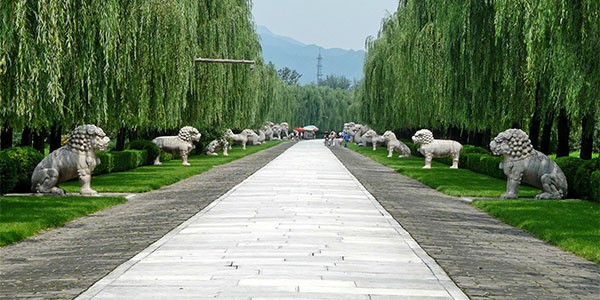
It took archaeologists two full years to safely renovate Changling in preparation for tourists and locals alike to see, first opening to the public in 1958. It’s quite a challenge getting to see the Dingling burial chamber; in fact it is a long way underground - and you need to be reasonably fit - but the effort is well worth the expenditure, and quite rewarding. Being so far underground really adds to the surreal atmosphere of these hallowed places of eternal rest, of the once high and mighty emperors.
Peking Roast Duck (北京烤鸭)
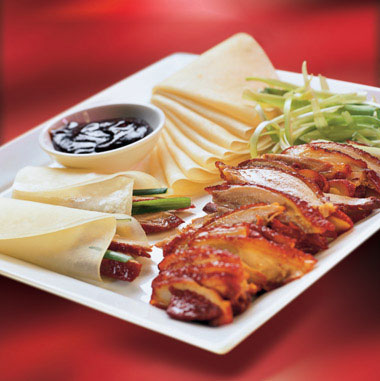 Let’s round
off the tour with a
gastronomic sensation – while you’re in Beijing, you must try the dish the city’s famous
for:
Peking roast duck. A visit to Beijing without enjoying a sumptuous
roast duck dinner is like visiting London and not popping into
Smithfield Market for fish and chips.
Peking duck – with its super succulent flesh and
perfect crispy skin cooked to perfection using closely guarded secret
spices – is truly a dish. Each duck is traditionally roasted over
fruit-tree wood for
extra taste, and eaten wrapped in a thin pancake with sweet bean sauce
and cucumber sticks. The combination is delectable.
Let’s round
off the tour with a
gastronomic sensation – while you’re in Beijing, you must try the dish the city’s famous
for:
Peking roast duck. A visit to Beijing without enjoying a sumptuous
roast duck dinner is like visiting London and not popping into
Smithfield Market for fish and chips.
Peking duck – with its super succulent flesh and
perfect crispy skin cooked to perfection using closely guarded secret
spices – is truly a dish. Each duck is traditionally roasted over
fruit-tree wood for
extra taste, and eaten wrapped in a thin pancake with sweet bean sauce
and cucumber sticks. The combination is delectable.
The only tough decision you’ll have to make when it comes time for some duck is which restaurant you’ll choose to dine at – because there are so many of them! One longtime favorite among both locals and visitors is Quanjude restaurant. This landmark eatery has been serving food since 1864... so it’s had plenty of time to perfect this most popular of Chinese culinary delights. You can find more useful Quanjude information here, including the location.
Trip Wrap Up
That wraps us up for our things to see in Beijing! I hope you feel well-equipped for an outstanding tour around China’s capital – there’s lots to see.
Honorable mention: if you have time to spare, stop by the Temple of Heaven; it’s a beautiful and iconic Beijing landmark, and one you won’t be sorry for squeezing in.
Have a great trip, and remember – Běijīng huānyíng (that’s "welcome to Beijing" for you, in Pinyin)!
Yours,
Cerise




Comments
Fun article! China is on my list of countries to visit, now I've moved it up to the top of the list.
Thanks for sharing this on the Byteful Travel Blog Carnival.
http://jimsgotweb.com
Thrilled to hear China's made it to the top of the list, Jim! I'm proud to have played my part helping to put it in that spot!
Cerise
Add new comment